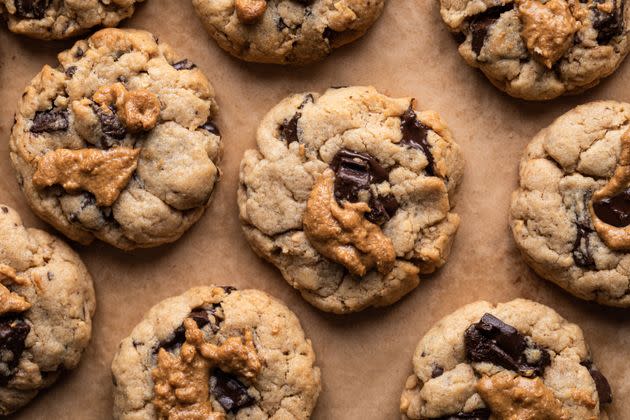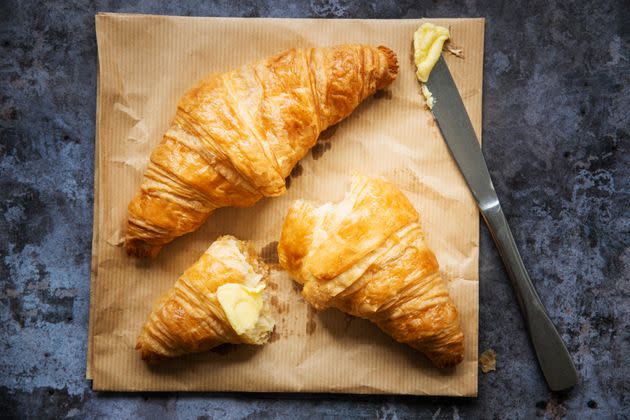When To Splurge On Expensive Baking Ingredients, And When To Use Cheap Stuff

If you watch enough fancy baking shows for long enough, you’re sure to eventually be exposed to “the talk.” That’s when the pastry chef of the moment pulls out the Tahitian vanilla beans ($378 a pound), To’ak Ecuadorian chocolate ($210 per 1.76-ounce bar) or Plugra European butter ($28.59 a pound) and explains why having the highest-quality ingredients makes a big difference in your baking. You might laugh off the idea of spending that much to try a recipe, but you may also have wondered whether specific items really improve the finished product that much.
Does ingredient quality really make a difference?
Even those of us who love to bake and do it all the time might hesitate to toss those pricey ingredients into a batch of cookies for the scout bake sale. But for a special occasion cake or other dessert, those splurges might make sense. If the occasion calls for it, the chefs we spoke to say it’s worth spending more on ingredients.
“Better-quality baking ingredients definitely make a noticeable difference in flavor, texture and aroma of desserts,” said Yoonjung Oh, executive pastry chef of Hive Hospitality. “Not every high-quality ingredient is essential, as some have a bigger impact than others, depending on what kind of desserts you’re making.”
It’s important to know that not every ingredient needs to break the bank — just the ones that will have the most prominent flavors. Oh said she mixes and matches pricey ingredients with cheaper ones, swapping in pricier choices that will make the biggest difference in a particular dish. “When I’m making chocolate desserts, I prioritize using high-quality cocoa powder and chocolate, but then I’ll use standard all-purpose flour, butter, eggs and milk for the rest of the recipe,” she said. “When I’m making something in which vanilla needs to shine, I’ll invest in vanilla beans for their rich aroma, but then I may economize on other ingredients.”
Penny Stankiewicz, chef-instructor of pastry and baking arts at the Institute of Culinary Education’s New York City campus, added this thought: “My rule of thumb is, if an ingredient is a key player, a dominant ingredient, or when there are only a few ingredients in the recipe, the quality matters so much more.”
Making a case for the cheap stuff.
You could spend a couple bucks on a bottle of imitation vanilla flavor or climb the high-priced heights with a pound ofTahitian vanilla beans, the rarest and most expensive of all varieties.While some say the cost is justified, others are fine with a thriftier approach.
Erika Kwee, also known as The Pancake Princess, is a food blogger and content creator who takes what she describes as a “perhaps controversial” approach when it comes to vanilla. “I sometimes use vanilla extract and imitation vanilla interchangeably,” she said, citing America’s Test Kitchen and Epicurious taste tests in which tasters couldn’t tell a difference in the baked goods, or in some cases, imitation vanilla won out.
“While I prefer to support high-quality vanilla producers like Heilala and Nielsen-Massey, I think imitation vanilla is one area where you can cut costs if needed,” Kwee said. “I’ve used both Adams and McCormick imitation vanilla.” She’s supported in her view by baker Helen S. Fletcher from the blog Pastries Like a Pro. “One of my pet peeves is the constant drumbeat of the need for ‘pure vanilla,’” she said. “I use McCormick’s imitation vanilla in a lot of my recipes, specifying the expensive brands only in more vanilla-forward recipes.”
Vanilla: Find a middle ground — or DIY it.
Many other bakers we spoke with said vanilla bean paste is a good middle ground in terms of that price-to-quality balance. A 4-ounce jar of Nielsen-Massey Pure Vanilla Bean Paste for Baking and Cooking can be found online for under $20. “It can be a cost-effective alternative to pure vanilla extract,” said Altreisha Foster, baker and owner of Sugar Spoon Desserts and president of The Cake Therapy Foundation.

Or you can save even more with a DIY option. “Where I might save money in baking is making my own vanilla,” said baker and food journalist Claire Ptak, author of “Love Is a Pink Cake.” After using vanilla pods to make custards or syrups, she gives them a second life by rinsing and drying the pods, then placing them in a bottle of vodka or simple syrup. “Vanilla extract is so expensive, and you get so much flavor from something you would have otherwise thrown away,” she said.
Another way to save is to cut back — or cut out — vanilla in some recipes. “I know some bakers who will omit vanilla altogether in applications like chocolate cake because they think the flavor gets masked anyway,” Kwee said. “So another way to cut costs is by only using vanilla where it will truly shine.”
Chocolate: Spend more for better results.
There’s one ingredient that experts felt was almost always worthy of a heftier price, and that’s chocolate. “Never buy cheap chocolate,” Ptak urged. “It isn’t really even chocolate, in my opinion.”
According to Christopher Vaughn, pastry chef for Jester Concepts in Minneapolis, that difference in quality has to do with care taken — or corners cut — in chocolate production. “Most chocolates in grocery stores have already begun to bloom,” he said. “That’s when cocoa butters begin to migrate and separate from the chocolate. Better-quality products are stored at better temperatures with less moisture to avoid bloom. Not only will it have a better flavor, but it will be less volatile and easier to work with.”
That’s especially true when it comes to the most chocolatey recipes. “I often use premium chocolate when that’s the main flavor, like in a mousse or ganache,” Foster said. On the other hand, it’s important to know your audience. “At a kids’ party, they may go very crazy for anything, despite its quality,” said Michael Zebrowski, associate professor at The Culinary Institute of America and author of “The Pastry Chef’s Little Black Book.” “Always know who you’re baking for, and buy accordingly.”
Kwee agreed: “Lots of people recognize Valrhona and Callebaut as top-tier baking chocolates, and I do love baking with them, but for a cheaper alternative, I also love Ghirardelli bittersweet 60% cacao baking chips ($10 for 10 ounces) and even Trader Joe’s semi-sweet chocolate chips ($3 for 12 ounces).
Prices do vary quite a bit. While a 1-pound block of Baker’s unsweetened chocolate can cost about $30, you could spend twice that or more for brands like Scharffen Berger or Guittard. In professional kitchens, Vaughn is partial to Valrhona chocolate, which is just under $70 for a little over 2 pounds. “It’s helpful that they offer different percentages of cocoa butter, depending on what the recipe calls for,” he said. “For home use, I usually buy Ghirardelli dark chocolate wafers ($43 for 5 pounds). It’s darker and has a better taste than most, plus it has a setting agent so there’s no need for tempering.”
Butter: Does it have a starring or supporting role?
Most of the time, your recipes are fine with traditional U.S. butter, these experts said — but you’ll often hear bakers singing the praises of European butter.
What’s the difference between U.S. and European butter? Butter in the average grocery store costs about $4 per pound and has 80% butterfat. But European butters, which are often much pricier, have about 82% to 86% butterfat. “Even that 2% makes a huge difference,” Vaughn explained. “The end result will be crispier and lighter, and cookies or cakes have better rise, not to mention exceptional taste.” Some highly rated and top-selling brands include Rodolphe le Meunier ($15 for 8.8 ounces), Ploughgate Creamery ($9 for 8 ounces) and Kerrygold Pure Irish butter ($4.29 for 8 ounces).
“For the average home baker, any inexpensive unsalted butter will be just fine for most applications,” Zebrowski said. “But the exception to this is in products when butter is the absolute star of the show, especially with laminated doughs like croissants, Danish and puff pastry,” he said. “If you’re making them, or other high-butter-fat products like brioche and buttercreams, spend on quality butter with a higher percentage of butterfat.”
And if you see the good stuff on sale and have the space, go ahead and buy in bulk. “High-fat products like butter freeze well,” Zebrowski said. “Wrap butter in its original packaging in aluminum foil, then put it in a freezer bag, pressing out the air and freezing for several months.”
Stankiewicz said that, for her chocolate cakes, she prefers vegetable oil as opposed to butter.
As these experts have said, choosing to go with a premium product might depend on the occasion or the type of recipe you’re baking. Here’s some further guidance from pastry chef Daniel Keehner, who teaches applied baking and pastry production at The Culinary Institute of America: “Save up and treat yourself to top-quality ingredients.”
“Don’t waste your money on fancy and silly tools — instead, go to farmers markets and local food shops and talk to people who cook with and sell these products,” he added. “Trust your own taste and learn your own style.”

